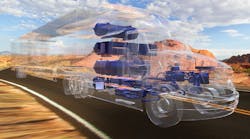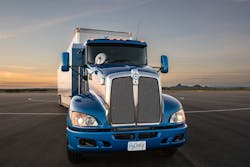The feasibility study called “Project Portal” will begin at the Port of Los Angeles this summer with the support of the California Air Resources Board (CARB) and the California Energy Commission (CEC). The CEC is investing in hydrogen fuel-cell infrastructure to support refueling needs while CARB follows the feasibility study to develop appropriate regulations and incentives to expand this market. The Los Angeles port is one of the largest stationary sources of pollution in the region and to reduce emissions in and around the ports, the 2017 Clean Air Action Plan (CAAP) proposes to gradually transition to zero-emission heavy commercial trucks by 2035. For the feasibility studies, a hydrogen fuel-cell truck from Toyota Motor North America will haul cargo between the port and warehouse facilities up to 70 miles away.
The concept’s gross combined weight capacity is 80,000 lb. and its estimated driving range is more than 200 miles per fill, under normal drayage operation. (Courtesy of Toyota)
“Hydrogen fuel-cell vehicles play a role in California’s efforts to achieve greenhouse-gas emission-reduction goals, improve air quality, and reduce our reliance on fossil fuels,” says Janea A. Scott, commissioner of the California Energy Commission. “That’s why the California Energy Commission is investing in the refueling infrastructure needed to support adoption of these vehicles. The Commission applauds Toyota for putting this cutting-edge technology to use in a heavy-duty freight proof of concept. This demo will show how fuel cells can help support the heavy-duty sector’s efforts to increase efficiency, transition to zero-emission technologies, and increase competitiveness.”
This technology has already been used as fuel for spaceships by NASA. Making it even more desirable and interesting is the fact that it is more efficient than diesel or gas. In addition, it has the potential to eliminate pollution caused by burning fossil fuels, reduce noise, and more. The technology must overcome disadvantages and challenges, too, such as the lack of hydrogen infrastructure. Planning for hydrogen infrastructure is very much needed, as it is so far an expensive power source solution. Also, fuel cells require water to be humidified to generate electricity. To ensure that vehicles operate under freezing conditions, vehicle designers needs to take this aspect into account.
According to Toyota, the truck was created using a Kenworth chassis. It generates more than 670 horsepower and 1,325 lb/ft. of torque from two Mirai fuel-cell stacks and a 12-kWh battery (a relatively small battery to support class 8 load operations). The Toyota Mirai was the first hydrogen fuel-cell vehicle to sell more than 200 units a year in the U.S.
“Toyota believes that hydrogen fuel-cell technology has tremendous potential to become the powertrain of the future,” says TMNA Executive Vice President Bob Carter. “From creating one of the world’s first mass-market fuel-cell vehicles, to introducing fuel-cell buses in Japan, Toyota is a leader in expanding the use of versatile and scalable zero-emission technology. With Project Portal, we’re proud to help explore the societal benefits of a true zero-emission heavy-duty truck platform.”
Kudos to studies like Toyota’s Project Portal for seeing a potential for the technology in California and opening the doors to zero-emission trucking. Fuel-cell technology for trucks is not in commercial production yet. But projects like these are the first step toward building a business case for the consideration and adoption of new zero-emission technologies where clean-air goals are a major economic driver.


